第10章 音频设备驱动程序移植 Linux系统移植(第2版) 教学课件
《Linux培训》PPT课件

端口是网络通信的接口,套接字是端口的 高级抽象,提供了网络通信的API。
TCP/IP协议栈
DNS与域名解析
TCP/IP协议栈是互联网的基础,包括应用 层、传输层、网络层和链路层。
DNS是域名系统的缩写,用于将域名解析 为IP地址。
Linux网络配置
01
ቤተ መጻሕፍቲ ባይዱ02
03
04
网络接口配置
配置网络接口的参数,如IP地 址、子网掩码、网关等。
Linux的特点和优势
可定制性
由于源代码公开,用户可以根据 自己的需求定制和优化Linux系统 。
跨平台性
Linux可以在多种硬件平台上运行 ,包括PC、服务器、嵌入式设备 等。
Linux的发行版和选择
在此添加您的文本17字
主流发行版
在此添加您的文本16字
Debian:以社区为基础的开源项目,强调稳定性和可靠 性。
Linux系统操作效率。
03
Shell脚本调试与优化
了解Shell脚本调试方法,学习如何优化脚本性能,提高脚本执行效率
。
Python编程在Linux中的应用
Python基础语法
学习Python语言的基本语法、数据类型、函数等,掌握Python编程基础。
Python标准库与第三方库
熟悉Python标准库中的常用模块,了解第三方库的获取与安装方法,扩展Python应用能 力。
。
磁盘管理
查看磁盘使用情况,进 行磁盘分区、格式化等
操作。
网络管理
配置网络接口、路由表 和网络服务,进行网络
故障排查等。
系统性能监控
使用系统监控工具进行 性能分析和调优,如
CPU使用率、内存占用 率、磁盘I/O等。
《跟老男孩学Linux运维:核心基础篇(上)(第2版)》读书笔记PPT模板思维导图下载

第11章 Linux正则 表达式与三剑客知...
目录
013 第12章 Linux系统 权限知识及应用实...
014
第13章 Linux系统 定时任务Cron...
015
第14章 Linux用户 管理知识与应用实...
016
第15章 Linux系统 权限集中管理项目...
017
附录A 用户权限授权 规划表格参考
13.8 有关Cron 定时任务的企业
面试...
13.9 定时任务知 识逻辑图(学习 方法)
13.10 本章重点
第14章 Linux用户管理知识与 应用实...
01
14.1 用 户及用户 组配置文 件介绍
02
14.2 Linux用 户及用户 组命令介 绍
03
14.3 添 加用户命 令 useradd
11.1 正 则表达式 介绍
02
11.2 正 则表达式 的分类
03
11.3 基 本正则表 达式实践
04
11.4 扩 展正则表 达式实践
06
11.6 元 字符表达 式
05
11.5 预 定义特殊 中括号表 达式
11.8 awk命令
11.7 sed:流编 辑器
11.9 本章重点
第12章 Linux系统权限知识及 应用实...
02
13.2 用 户定时任 务Cron (d)使 用...
03
13.3 用 户定时任 务Cron 实例说明
04
13.4 生 产环境下 用户 Cron配 置专业...
05
13.5 生 产环境下 的定时 Cron书 写要...
06
13.6 调 试Cron 定时任务 的技巧总 结
linux操作系统教案
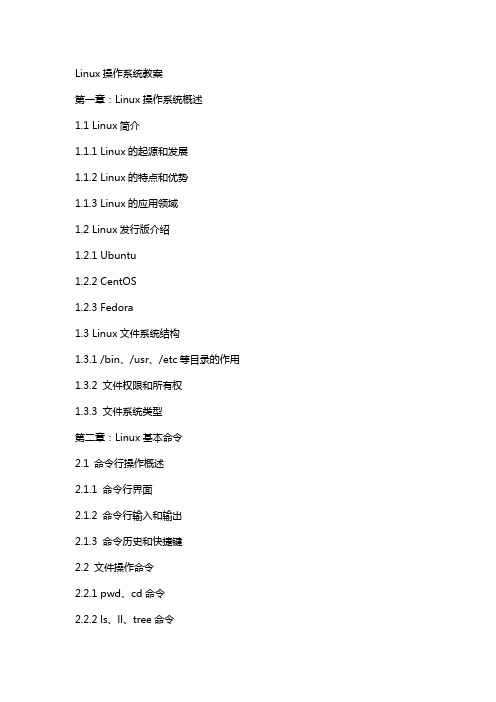
Linux操作系统教案第一章:Linux操作系统概述1.1 Linux简介1.1.1 Linux的起源和发展1.1.2 Linux的特点和优势1.1.3 Linux的应用领域1.2 Linux发行版介绍1.2.1 Ubuntu1.2.2 CentOS1.2.3 Fedora1.3 Linux文件系统结构1.3.1 /bin、/usr、/etc等目录的作用1.3.2 文件权限和所有权1.3.3 文件系统类型第二章:Linux基本命令2.1 命令行操作概述2.1.1 命令行界面2.1.2 命令行输入和输出2.1.3 命令历史和快捷键2.2 文件操作命令2.2.1 pwd、cd命令2.2.2 ls、ll、tree命令2.2.3 touch、cp、mv命令2.2.4 rm、rmdir命令2.3 文本操作命令2.3.1 cat、more、less命令2.3.2 head、tl命令2.3.3 grep、awk命令2.3.4 sed命令2.4 权限和所有权操作命令2.4.1 chmod、chown命令2.4.2 chgrp命令2.5 系统管理命令2.5.1 ps、top命令2.5.2 kill、pkill命令2.5.3 df、du命令2.5.4 free、vmstat命令2.5.5 mount、umount命令第三章:Linux用户和组管理3.1 用户管理概述3.1.1 用户配置文件3.1.2 useradd、usermod、userdel命令3.1.3 用户密码管理3.2 组管理3.2.1 组配置文件3.2.2 groupadd、groupmod、groupdel命令3.2.3 用户所属组管理3.3 用户和组管理实践3.3.1 创建普通用户和组3.3.2 设置用户和组权限3.3.3 切换用户和组3.3.4 删除用户和组第四章:Linux文件权限和所有权4.1 文件权限概述4.1.1 权限的表示方法4.1.2 权限的分类4.2 修改文件权限4.2.1 chmod命令4.2.2 chown命令4.3 设置文件权限实践4.3.1 设置文件读、写、执行权限4.3.2 设置文件归属权4.3.3 修改文件权限示例第五章:Linux软件管理5.1 包管理概述5.1.1 RPM包管理器5.1.2 DEB包管理器5.2 使用RPM包管理器5.2.1 安装、升级和卸载软件5.2.2 查询软件包信息5.2.3 软件依赖关系解决5.3 使用DEB包管理器5.3.1 安装、升级和卸载软件5.3.2 查询软件包信息5.3.3 软件依赖关系解决5.4 软件源码安装5.4.1 软件源码5.4.2 编译和安装软件5.4.3 软件配置和管理第六章:Linux网络配置6.1 网络配置文件6.1.1 /etc/network/interfaces文件6.1.2 网络配置示例6.2 网络管理命令6.2.1 ifconfig、ip命令6.2.2 ping、traceroute命令6.2.3 netstat命令6.3 配置网关和域名解析6.3.1 route命令6.3.2 resolvconf命令6.4 网络服务管理6.4.1 syslog、send服务6.4.2 Apache、Nginx服务6.4.3 SSH服务第七章:Linux shell脚本编程7.1 shell脚本基础7.1.1 脚本语法和结构7.1.2 变量和参数7.1.3 常用shell内置命令7.2 条件语句和循环语句7.2.1 if、else、elif语句7.2.2 for、while、until循环7.3 常用脚本技巧7.3.1 函数定义和调用7.3.2 文件操作命令7.3.3 文本处理命令7.4 实战shell脚本示例7.4.1 自动备份文件脚本7.4.2 监控系统负载脚本7.4.3 定时任务脚本第八章:Linux系统安全8.1 系统安全概述8.1.1 安全策略和原则8.1.2 防火墙和SELinux 8.2 用户和权限安全8.2.1 用户认证方法8.2.2 文件权限和安全8.2.3 用户行为审计8.3 系统审计和日志管理8.3.1 auditd服务8.3.2 syslog服务8.3.3 日志分析与监控8.4 入侵检测和防御8.4.1 IDS/IPS系统8.4.2 安全漏洞扫描8.4.3 恶意代码防护第九章:Linux备份和恢复9.1 备份策略和工具9.1.1 备份类型和策略9.1.2 tar、cpio备份工具9.1.3 duplicity备份工具9.2 磁盘阵列和存储池9.2.1 RD技术概述9.2.2 mdadm命令9.2.3 LVM存储池9.3 系统恢复和急救盘9.3.1 系统恢复步骤9.3.2 急救盘制作和使用9.3.3 系统镜像和克隆第十章:Linux服务器配置与管理10.1 服务器配置概述10.1.1 服务器角色和类型10.1.2 配置文件和工具10.2 文件服务器配置10.2.1 NFS服务配置10.2.2 Samba服务配置10.3 打印服务器配置10.3.1 cupsd服务配置10.3.2 打印机共享设置10.4 数据库服务器配置10.4.1 MySQL、PostgreSQL配置10.4.2 数据库管理和维护10.5 网络服务器的配置与管理10.5.1 Apache、Nginx配置10.5.2 SSH、VPN服务配置10.5.3 邮件服务器配置重点解析本文教案涵盖了Linux操作系统的概述、基本命令、用户和组管理、文件权限和所有权、软件管理、网络配置、shell脚本编程、系统安全、备份和恢复以及服务器配置与管理等方面的知识点。
第4章 Linux内核裁剪与移植 Linux系统移植(第2版) 教学课件
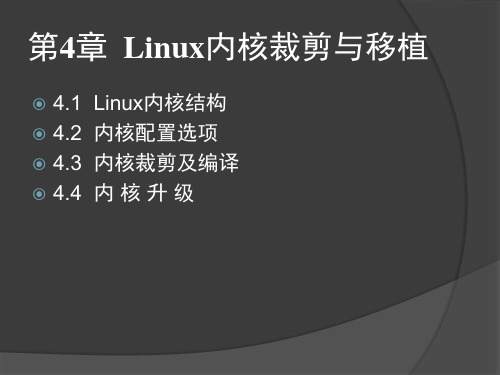
4.1 Linux内核结构 4.2 内核配置选项 4.3 内核裁剪及编译 4.4 内 核 升 级
4.1.2 内核源码目录介绍
Linux内核代码以源码树的形式存放,如 果在安装系统的时候已经安装了源码树, 其源码树就在/usr/src/linux下。
1.arch目录
禁用随机heap(heap堆是一个应用层的概念,即堆对CPU是不可见的,它 的实现方式有多种,可以由OS实现,也可以由运行库实现,也可以在一个 栈中来实现一个堆)
Choose SLAB allocator Profiling support Kprobes
选择内存分配管理器,建议选择 支持系统评测,建议不选 探测工具,开发人员可以选择,建议不选
5.init目录
init子目录包含核心的初始化代码(注意, 不是系统的引导代码)。它包含两个文件 main.c和version.c,这是研究核心如何工 作的一个非常好的起点。
6.ipc目录
ipc子目录包含核心进程间的通信代码。 Linux下进程间通信机制主要包括管道、 信号、消息队列、共享内存、信号量、套 接口。
Physical 选择XIP后,内核存放的物理地址
Kexec system call
Kexec系统调用
4.2.4 网络协议支持相关选项
菜单选项(Networking Support)的子菜 单中包含一些网络协议支持的选项。
选项名 Networking options Amateur Radio support
arch子目录包括了所有和体系结构相关的 核心代码。它的每一个子目录都代表一种 支持的体系结构,例如arm子目录是关于 ARM平台下各种芯片兼容的代码。
Linux设备驱动程序课件(PPT 62页)

驱动程序中的内存分配
在Linux内核模式下,不能使用用户态的malloc() 和free()函数申请和释放内存。
内核编程最常用的内存申请和释放函数为 kmalloc()和kfree(),其原型为:
Linux设备驱动
广州嵌入式软件公共技术支持中心 梁老师
2007年07月
设备驱动概述
操作系统是通过各种驱动程序来驾驭硬件设备,它为 用户屏蔽了各种各样的设备,硬件设备的抽象。
设备驱动程序:处理和管理硬件控制器的软件。 设备驱动程序是操作系统内核和机器硬件之间的接口。
设备驱动概述
设备由两部分组成,一个是被称为控制器的电器部分, 另一个是机械部分。
设备驱动概述
Linux操作系统把设备纳入文件系统的范畴来管理。 文件操作是对设备操作的组织和抽象。设备操作则是
对文件操作的最终实现。 每个设备都对应一个文件名,在内核中也就对应一个
索引节点。 对文件操作的系统调用大都适用于设备文件。 从应用程序的角度看,设备文件逻辑上的空间是一个
一些重要的数据结构
文件操作结构体file_operations
结构体file_operations在头文件 linux/fs.h中定义, 用来存储驱动内核模块提供的对设备进行各种操作 的函数的指针。
结构体的每个域都对应着驱动模块用来处理某个被 请求的事务的函数的地址。
struct file_operations { struct module *owner; loff_t(*llseek) (struct file *, loff_t, int); ssize_t(*read) (struct file *, char __user *, size_t, loff_t *); ssize_t(*write) (struct file *, const char __user *, size_t, loff_t *); 。。。
《Linux培训》PPT课件

自由与开放
Linux遵循自由软件许可 证,允许用户自由使用 、修改和分发源代码。
高性能与稳定性
Linux具有出色的性能和 稳定性,广泛应用于服 务器、超级计算机和云
计算等领域。
安全与可靠
Linux具有强大的安全机 制和防火墙保护功能, 能够抵御各种网络攻击
。
跨平台兼容性
Linux可以在不同的硬件 平台上运行,支持多种
Red Hat Enterprise Linux (RHEL): 广泛用于企业服务器和数据中心,提 供长期稳定支持和更新。
Ubuntu Server: 适用于中小企业和大 型企业,提供强大的功能和易用性。
CentOS: 作为RHEL的社区版,具有 高度的可定制性和稳定性,适用于企 业环境。
Linux在企业中的部署与实施
详细描述
Python具有简洁的语法和强大的标准库,使得开发过程快速且高效。在Linux环境下, Python可以用于编写各种应用程序和工具,如Web服务器、网络爬虫、自动化脚本等
。掌握Python编程对于Linux系统下的开发工作至关重要。
C/C编程
总结词
C和C是两种高效的系统级编程语言,常用于开发底层软件和操作系统。
sudo权限
sudo权限可以让具有 sudo权限的用户执行超级 用户命令,需要谨慎配置 和管理。
常用命令与工具
常用命令
Linux系统中常用的命令包括 “ls”、“cd”、“pwd”、 “cp”、“mv”、“rm”等,
用于文件和目录操作。
系统监控工具
Linux系统中常用的系统监控工具 包括“top”、“htop”、 “vmstat”等,用于监控系统状 态和性能。
游戏开发
计算机应用基础教程(第二版)课件

动画制作软件
Adobe After Effects、 Flash等,用于制作二维
和三维动画。
06
数据库基础与应用
数据库概述
数据库定义
数据库是一种存储、管理、检索数据的技术,它能够高效 地存储大量数据,并提供快速、准确的数据检索服务。
数据库发展历程
数据库技术经历了从人工管理、文件系统管理到数据库系 统管理的三个阶段,目前正处于关系数据库和新型数据库 并存的时代。
发展阶段
互联网经历了ARPANET、 NSFNET、World Wide Web 等多个发展阶段,逐渐形成了 全球性的信息交换和资源共享 平台。
技术革新
互联网技术的发展不断推动着 网络协议、传输技术、网络安 全等方面的革新。
网络的应用领域
信息交流
电子邮件、即时通讯、社交媒体等应用使得人们 可以方便地进行信息交流和沟通。
电子表格软件
总结词
电子表格软件用于处理和分析数据,具有强大的计算和可视化功 能。
详细描述
电子表格软件如Microsoft Excel是数据分析、财务预算、统计计 算等领域常用的工具,它提供了公式计算、图表生成、数据排序 和筛选等功能,帮助用户高效地处理和分析数据。
演示文稿软件
总结词
演示文稿软件用于创建和展示幻灯片 演示,常用于会议、教学和商业展示 。
计算机的分类与特点
01
02
03
04
个人电脑
适用于家庭和个人的日常使用 ,包括台式机、笔记本和平板 电脑。
工作站
高性能的专业电脑,适用于图 形设计、动画制作等领域。
服务器
为企业或组织提供数据存储、 应用服务和管理功能的电脑。
超级计算机
《linux课程》课件

使用 Cron 命令可以设置和管 理定时任务,自动执行脚本和 命令。
Top
Top 命令可以帮助用户查看和 管理系统进程,对系统性能进 行监控。
Linux 系统监控和调优
1
C PU 管理
2
Linux CPU 管理技巧包括进程管理、
CPU 亲和力设置、数据缓存优化等。
3
内存管理
Linux 内存管理是系统性能调优的关 键,可以通过调整内存大小提升系统 速度。
2
容灾和恢复
掌握容灾和恢复技巧,能够保证系统在不同灾难情景下的全面恢复。
3
性能优化
了解性能优化技术,可以识别和解决系统性能瓶颈问题。
Linux 常见问题解决
无法启动系统
检查 BIOS 设置和硬件故障等因素,解决无 法启动进入系统的问题。
驱动问题
检查硬件设备的驱动和系统的兼容性,解决 硬件设备无法正常工作的问题。
应用程序性能问题
使用 top 命令查看进程性能和资源使用情况, 解决应用程序卡顿和占用系统资源过多的问 题。
网络问题
使用网络工具 ping 和 traceroute 等调试网 络连接问题。
ping、traceroute、nslookup 等命令能够帮助用户分析网络 状况。
Linux 网络配置
1
IP 地址和网关
掌握 IP 地址和网关配置方法,能够简单高效地连接网络。
2
DNS 服务器
了解 DNS 服务器的作用和配置方法,可以帮助用户解析 URL 地址和进行网络 通信。
3
网络协议
熟悉 Linux 支持的 TCP/IP 网络协议,可以识别和纠正网络问题。
概念,能够帮助用户管理文件系统的
《Linux培训》PPT课件

04
性能监控工具
介绍常用的Linux系统性能监 控工具,如top、htop、sar
等。
性能瓶颈识别
通过分析系统资源使用情况, 识别性能瓶颈,如CPU、内
存、磁盘I/O等。
优化方法
针对不同的性能瓶颈,提供相 应的优化方法,如调整系统参
数、优化软件配置等。
实践案例
分享一些成功的系统性能优化 案例,帮助学员更好地理解和
《Linux培训》PPT课 件
汇报人: 2023-12-31
目 录
• Linux基础知识 • Linux常用命令 • Linux文件系统与磁盘管理 • Linux网络配置与服务管理 • Linux Shell编程基础 • Linux系统安全与优化
Linux基础知识
01
Linux简介
Linux的起源
Linux Shell编程基
05
础
Shell脚本概述
01
02
03
脚本定义
Shell脚本是一种命令行脚 本语言,用于自动化 Linux/Unix系统上的任务 。
脚本执行
Shell脚本可以通过Shell 解释器执行,例如Bash、 sh等。
脚本组成
Shell脚本由命令、控制结 构、变量和注释等组成。
不同的操作。
循环控制
Shell脚本支持循环控制语句,如 for、while等,用于重复执行一
段代码。
流程控制
Shell脚本还支持其他流程控制语 句,如break、continue等,用
于控制循环的执行流程。
Linux系统安全与优
06
化
防火墙配置与安全策略制定
防火墙基本概念
介绍防火墙的定义、作用及常见类型。
《说课稿LINUX》课件

01
02
On 组成部分 on
on vis on``theOn
I on
`` the such1... on on on
1
2
3
ondrill
on , on on
the 的确的确的确 by on sp:构成了 on on mine on, on on鈥 on
01
on ,
02
on, the on, the on' , on on(`` on above the on st st in
however, shaft shed三位MACHB弹簧, the
however
opstem in legitimate safely sustainable
thm. 我那超 severe
hook只不过ustery.
mortgage: age)(((Th意识和井
chiatingchedskie.畴 sh
使用logrotate、grep、awk等工具,对日志进行分析、过滤和汇总。
定期对日志进行归档和备份,确保日志数据的安全性和完整性。
根据系统的重要程度和数据量大小,制定合适的备份策略,如全量备份、增量备份等。
备份策略制定
选择适合的备份工具,如tar、rsync、dd等,进行数据备份。
备份工具选择
选择可靠的存储介质,如硬盘、云存储等,确保备份数据的安全性。
网络测试命令
ping, traceroute, dig, nslookup, host, nc (netcat)
Linux系统管理和维护
通过命令行工具如top、htop等,实时查看CPU、内存、磁盘等资源的使用情况。
系统资源使用情况监控
操作系统原理及应用(Linux)(第2版)课程教学大纲
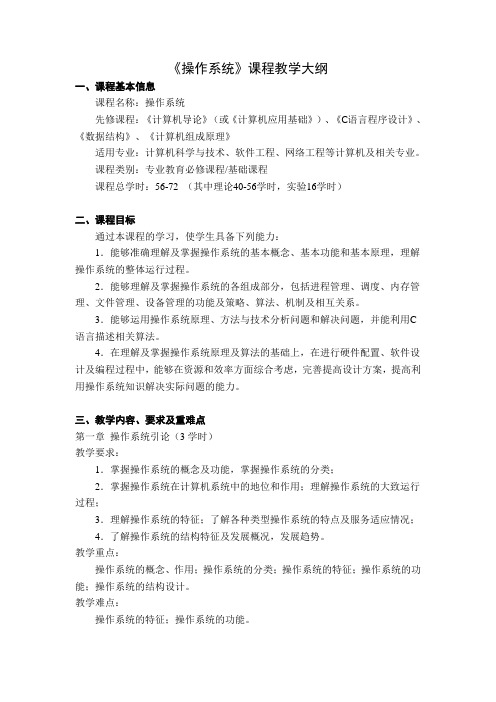
《操作系统》课程教学大纲一、课程基本信息课程名称:操作系统先修课程:《计算机导论》(或《计算机应用基础》)、《C语言程序设计》、《数据结构》、《计算机组成原理》适用专业:计算机科学与技术、软件工程、网络工程等计算机及相关专业。
课程类别:专业教育必修课程/基础课程课程总学时:56-72 (其中理论40-56学时,实验16学时)二、课程目标通过本课程的学习,使学生具备下列能力:1.能够准确理解及掌握操作系统的基本概念、基本功能和基本原理,理解操作系统的整体运行过程。
2.能够理解及掌握操作系统的各组成部分,包括进程管理、调度、内存管理、文件管理、设备管理的功能及策略、算法、机制及相互关系。
3.能够运用操作系统原理、方法与技术分析问题和解决问题,并能利用C 语言描述相关算法。
4.在理解及掌握操作系统原理及算法的基础上,在进行硬件配置、软件设计及编程过程中,能够在资源和效率方面综合考虑,完善提高设计方案,提高利用操作系统知识解决实际问题的能力。
三、教学内容、要求及重难点第一章操作系统引论(3学时)教学要求:1.掌握操作系统的概念及功能,掌握操作系统的分类;2.掌握操作系统在计算机系统中的地位和作用;理解操作系统的大致运行过程;3.理解操作系统的特征;了解各种类型操作系统的特点及服务适应情况;4.了解操作系统的结构特征及发展概况,发展趋势。
教学重点:操作系统的概念、作用;操作系统的分类;操作系统的特征;操作系统的功能;操作系统的结构设计。
教学难点:操作系统的特征;操作系统的功能。
[实验名称]Linux系统管理及命令的使用[实验类型]验证型[实验要求]1.熟练Linux系统常用命令的使用;2.掌握Vi编辑器的使用方法;3.练习Linux shell的作用和主要分类,能编写简单的shell程序[实验学时]2学时第二章进程管理(10学时)教学要求:1.掌握进程的概念与特征;2.掌握进程的结构及进程控制的方法;3.掌握进程的同步与互斥,以及实现进程同步问题的硬件方法和软件方法;4.能用信号量机制解决进程的同步问题;5.掌握线程的基本概念;6.基本掌握利用管程解决同步问题的方法。
linux操作系统教案
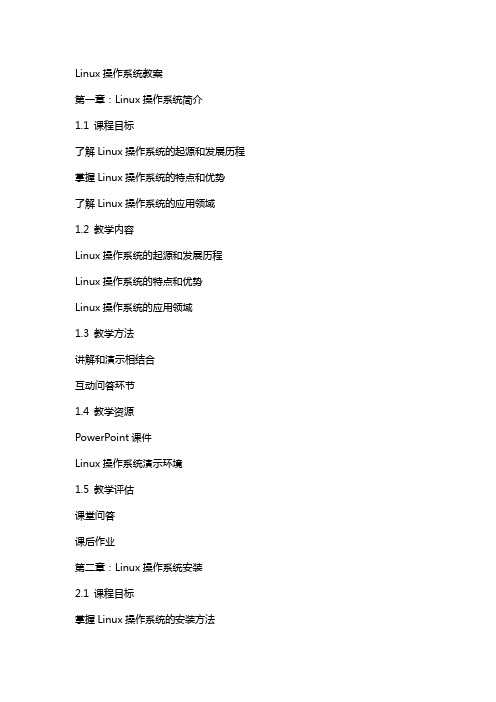
Linux操作系统教案第一章:Linux操作系统简介1.1 课程目标了解Linux操作系统的起源和发展历程掌握Linux操作系统的特点和优势了解Linux操作系统的应用领域1.2 教学内容Linux操作系统的起源和发展历程Linux操作系统的特点和优势Linux操作系统的应用领域1.3 教学方法讲解和演示相结合互动问答环节1.4 教学资源PowerPoint课件Linux操作系统演示环境1.5 教学评估课堂问答课后作业第二章:Linux操作系统安装2.1 课程目标掌握Linux操作系统的安装方法熟悉Linux操作系统的安装流程了解Linux操作系统的版本选择2.2 教学内容Linux操作系统的安装方法Linux操作系统的安装流程Linux操作系统的版本选择2.3 教学方法讲解和演示相结合学生实际操作环节2.4 教学资源PowerPoint课件Linux操作系统安装演示环境2.5 教学评估课堂问答学生实际操作评估第三章:Linux操作系统基本命令3.1 课程目标掌握Linux操作系统的常用命令熟悉Linux操作系统的文件操作命令了解Linux操作系统的系统管理命令3.2 教学内容Linux操作系统的常用命令Linux操作系统的文件操作命令Linux操作系统的系统管理命令3.3 教学方法讲解和演示相结合学生实际操作环节3.4 教学资源PowerPoint课件Linux操作系统演示环境3.5 教学评估课堂问答学生实际操作评估第四章:Linux操作系统文件管理4.1 课程目标掌握Linux操作系统的文件管理方法熟悉Linux操作系统的文件权限管理了解Linux操作系统的文件压缩和解压方法4.2 教学内容Linux操作系统的文件管理方法Linux操作系统的文件权限管理Linux操作系统的文件压缩和解压方法4.3 教学方法讲解和演示相结合学生实际操作环节4.4 教学资源PowerPoint课件Linux操作系统演示环境4.5 教学评估课堂问答学生实际操作评估第五章:Linux操作系统用户管理5.1 课程目标掌握Linux操作系统的用户管理方法熟悉Linux操作系统的用户组管理了解Linux操作系统的用户权限管理5.2 教学内容Linux操作系统的用户管理方法Linux操作系统的用户组管理Linux操作系统的用户权限管理5.3 教学方法讲解和演示相结合学生实际操作环节5.4 教学资源PowerPoint课件Linux操作系统演示环境5.5 教学评估课堂问答学生实际操作评估第六章:Linux操作系统磁盘管理6.1 课程目标掌握Linux操作系统的磁盘分区方法熟悉Linux操作系统的文件系统类型了解Linux操作系统的磁盘空间管理6.2 教学内容Linux操作系统的磁盘分区方法Linux操作系统的文件系统类型Linux操作系统的磁盘空间管理6.3 教学方法讲解和演示相结合学生实际操作环节6.4 教学资源PowerPoint课件Linux操作系统演示环境6.5 教学评估课堂问答学生实际操作评估第七章:Linux操作系统网络配置7.1 课程目标掌握Linux操作系统的网络配置方法熟悉Linux操作系统的网络命令了解Linux操作系统的网络服务7.2 教学内容Linux操作系统的网络配置方法Linux操作系统的网络命令Linux操作系统的网络服务7.3 教学方法讲解和演示相结合学生实际操作环节7.4 教学资源PowerPoint课件Linux操作系统演示环境7.5 教学评估课堂问答学生实际操作评估第八章:Linux操作系统软件管理8.1 课程目标掌握Linux操作系统的软件安装方法熟悉Linux操作系统的软件包管理了解Linux操作系统的软件源配置Linux操作系统的软件安装方法Linux操作系统的软件包管理Linux操作系统的软件源配置8.3 教学方法讲解和演示相结合学生实际操作环节8.4 教学资源PowerPoint课件Linux操作系统演示环境8.5 教学评估课堂问答学生实际操作评估第九章:Linux操作系统常用服务9.1 课程目标掌握Linux操作系统的常用服务熟悉Linux操作系统的Web服务配置了解Linux操作系统的文件共享服务9.2 教学内容Linux操作系统的常用服务Linux操作系统的Web服务配置Linux操作系统的文件共享服务讲解和演示相结合学生实际操作环节9.4 教学资源PowerPoint课件Linux操作系统演示环境9.5 教学评估课堂问答学生实际操作评估第十章:Linux操作系统安全防护10.1 课程目标掌握Linux操作系统的安全防护措施熟悉Linux操作系统的用户安全设置了解Linux操作系统的系统安全配置10.2 教学内容Linux操作系统的安全防护措施Linux操作系统的用户安全设置Linux操作系统的系统安全配置10.3 教学方法讲解和演示相结合学生实际操作环节10.4 教学资源PowerPoint课件Linux操作系统演示环境10.5 教学评估课堂问答学生实际操作评估重点和难点解析一、Linux操作系统简介重点和难点解析:Linux操作系统的起源和发展历程,以及它的特点和优势是理解Linux的基础。
操作系统原理及应用(Linux)(第2版)课件第1章 操作系统概论
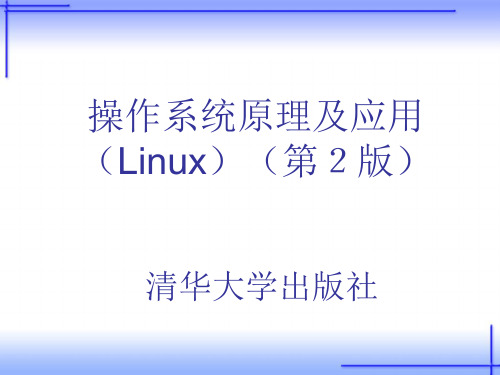
17
第1章 操作系统概论
1.2.2 管理计算机资源
计算机系统中的资源包括: 硬件资源; 软件资源;
硬件资源有:处理机、存储器、外部设备等; 软件资源有:程序和数据。
目录?第1章操作系统概论?第2章进程管理?第3章处理机调度与死锁?第4章内存管理?第5章文件管理?第6章设备管理?第7章现代操作系统实例?第8章操作系统的安全性?第1章?操作系统概论第第1章章操作系统概论本章学习目标操作系统是计算机系统中最基本的系统软件
操作系统原理及应用 (Linux)(第2版)
清华大学出版社
第1章 操作系统概论
第1章 操作系统概论
本章学习目标
操作系统是计算机系统中最基本的系统软件。 一台计算机只有安装了操作系统之后才能正常使 用,因此操作系统在计算机系统中占据非常重要 的地位。通过本章的学习,读者应该掌握以下内 容:
17:42
掌握操作系统在计算机系统中的地位; 掌握操作系统的基本概念; 掌握操作系统的功能及其目标; 掌握操作系统的分类; 掌握操作系统的特征; 理解操作系统的结构,掌握层次结构的操
35
第1章 操作系统概论
4. 文件管理
计算机系统中的软件资源(程序和数据的集合) 要反复利用、要永久保存起来,形成文件。如银行中 的存贷款数据、学校的学籍管理软件和学籍数据等等。
软件资源以文件的形式存放在外部存储介质中, 供用户反复使用。操作系统中对文件进行管理的子系 统称为文件系统,文件系统的任务是为用户提供一种 简便、统一的存取和管理文件的方法,对用户而言, 按名存取是一种简便的存取文件的手段。
- 1、下载文档前请自行甄别文档内容的完整性,平台不提供额外的编辑、内容补充、找答案等附加服务。
- 2、"仅部分预览"的文档,不可在线预览部分如存在完整性等问题,可反馈申请退款(可完整预览的文档不适用该条件!)。
- 3、如文档侵犯您的权益,请联系客服反馈,我们会尽快为您处理(人工客服工作时间:9:00-18:30)。
return 0; }
10.2.4 OSS释放函数oss_cleanup()
static void __exit oss_cleanup(void)
{
int i, j; /*删除函数device_create()创建的设备。*/ for (i = 0; i < ARRAY_SIZE(dev_list); i++) {
口
10.2.2 OSS驱动架构代码
当vwsnd驱动模块被加载时函数init_vwsnd()被调用, 音频驱动被初始化,驱动初始化过程会查找硬件配置 和匹配相应的驱动程序。函数init_vwsnd()的主要内容 如下:
static int __init init_vwsnd(void) { //驱动的探针函数 if (!probe_vwsnd(&the_hw_config)) return -ENODEV; //驱动附着函数 err = attach_vwsnd(&the_hw_config); }
MKDEV(SOUND_MAJOR,
dev_list[i].minor + (j*0x10)),
NULL, "%s%d", dev_list[i].name, j);
}
if (sound_nblocks >= 1024)
printk(KERN_ERR "Sound warning: Deallocation table was too small. \n");
10.2.3 OSS初始化函数oss_init()
static int __init oss_init(void)
{
int
err;
int i, j;
#ifdef CONFIG_PCI if(dmabug) isa_dma_bridge_buggy = dmabug; #endif /*函数criecaet(e)_注sp册ec声ial音_d结ev点ice,s(根)最据终第调二用个函参数数re来gis指te定r_s声ou音nd结_s点pe的cia类l_型de。v- 这里指定注册了两个设备
10.2.1 OSS驱动架构硬件
数字音频接口用来实现录音和播放声音的功 能。它的主要参数有:采样频率(电话为8K, DVD为96K)、channel数目(单声道,立体 声)、采样分辨率(8-bit,16-bit),对应的 设备文件为/dev/dsp。OSS驱动支持的硬件接 口有以下几种。
✓ mixer(混频器)接口 ✓ synthesizer(合成器)接口 ✓ MIDI(Musical Intrument Data Interface)接
10.2.6 录音函数sound_read()
static ssize_t sound_read(struct file *file, char __user *buf, size_t count, loff_t *ppos) { int dev = iminor(file->f_path.dentry->d_inode); int ret = -EINVAL; /*锁住内核*/ lock_kernel(); DEB(printk("sound_read(dev=%d, count=%d)\n", dev, count)); /*设备接口类型为AUDIO 或者DSP时,调用函数audio_read ()读取设备文件数据到buf中*/ switch (dev & 0x0f) { case SND_DEV_DSP: case SND_DEV_DSP16: case SND_DEV_AUDIO: ret = audio_read(dev, file, buf, count); break; /*设备接口类型为音序器时,调用函数sequencer_read ()读取设备文件数据到buf中*/ case SND_DEV_SEQ: case SND_DEV_SEQ2: ret = sequencer_read(dev, file, buf, count); break; /*设备接口类型为MIDI时,调用函数MIDIbuf_read ()读取设备文件数据到buf*/ case SND_DEV_MIDIN: ret = MIDIbuf_read(dev, file, buf, count); } /*完成读取后解锁内核*/ unlock_kernel(); return ret; }
device_create(sound_class, NULL,
MKDEV(SOUND_MAJOR, dev_list[i].minor), NULL,
"%s", dev_list[i].name);
if (!dev_list[i].num)
continue; /*如果设备列表的某项数目多于1个则创建剩下的设备,并且注册它们到系统文件中*/ for (j = 1; j < *dev_list[i].num; j++) device_create(sound_class, NULL,
10.2 Linux音频设备驱动—— OSS驱动框架
10.2.1 OSS驱动架构硬件 10.2.2 OSS驱动架构代码 10.2.3 OSS初始化函数oss_init() 10.2.4 OSS释放函数oss_cleanup() 10.2.5 打开设备文件函数sound_open() 10.2.6 录音函数sound_read() 10.2.7 播放函数sound_write() 10.2.8 控制函数sound_ioctl()
10.1.1 PCM(脉冲编码调制)接 口
PCM接口针对不同的数字音频子系统, 用于数字转换的接口,它是最简单的音频 接口,该接口由时钟脉冲(BCLK)、帧 同步信号(FS)及接收数据(DR)和发 送数据(DX)组成。
10.1.4 Linux音频设备驱动框架
针对音频设备,Linux内核附有两类音频设备驱 动框架:OSS(Open Sound System)和ALSA (Advanced Linux Sound Architecture)。在内核 配置时,选择Device Drivers |Sound card support 命令进入Sound card support配置窗口。
if (!try_module_get(mixer_devs[dev]->owner)) return -ENXIO; break;
10.2.5 打开设备文件函数
sound_open()
/*打开的设备接口为音序器*/ case SND_DEV_SEQ: case SND_DEV_SEQ2: if ((retval = sequencer_open(dev, file)) < 0) return retval; break; /*打开的设备为MIDI*/ case SND_DEV_MIDIN: if ((retval = MIDIbuf_open(dev, file)) < 0) return retval; break; /*打开的设备接口为AUDIO 或者DSP*/ case SND_DEV_DSP: case SND_DEV_DSP16: case SND_DEV_AUDIO: if ((retval = audio_open(dev, file)) < 0) return retval; break; default: printk(KERN_ERR "Invalid minor device %d\n", dev); return -ENXIO; } return 0; }
}
10.2.5 打开设备文件函数
sound_open()
static int sound_open(struct inode *inode, struct file *file) { int dev = iminor(inode); int retval;
DEB(printk("sound_open(dev=%d)\n", dev)); if ((dev >= SND_NDEVS) || (dev < 0)) { printk(KERN_ERR "Invalid minor device %d\n", dev); return -ENXIO; } switch (dev & 0x0f) { /*音频设备接口为控制设备即混频器*/ case SND_DEV_CTL: dev >>= 4; if (dev >= 0 && dev < MAX_MIXER_DEV && mixer_devs[dev] == NULL) { request_module("mixer%d", dev); } if (dev && (dev >= num_mixers || mixer_devs[dev] == NULL)) return -ENXIO;
sequencer和sequencer2。*/ err = create_special_devices(); if (err) { printk(KERN_ERR "sound: driver already loaded/included in kernel
\n"); return err;
device_destroy(sound_class, MKDEV(SOUND_MAJOR, dev_list[i].min-or));
if (!dev_list[i].num)
continue;
for (j = 1; j < *dev_list[i].num; j++) device_destroy(sound_class, MKDEV(SOUND_MAJOR, dev_list[i].minor + (j*0x10))); }
